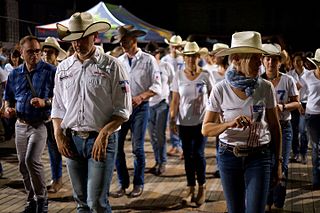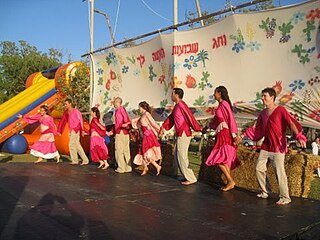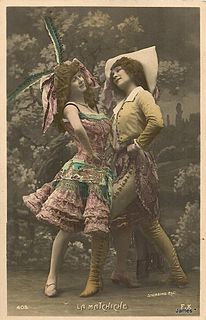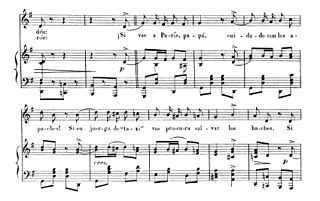Related Research Articles
Dance moves or dance steps are usually isolated, defined, and organized so that beginning dancers can learn and use them independently of each other. However, more complex movements are influenced by musicality and lyrical relevance to express emotions or refer to a message. Dance moves tend to emphasize the concepts of lead and follow and connection.

A line dance is a choreographed dance in which a group of people dance along to a repeating sequence of steps while arranged in one or more lines or rows. These lines usually face all in the same direction, or less commonly face each other. Unlike circle dancing, line dancers are not in physical contact with each other. Each dance is usually associated with, and named for, a specific song, such as the Cha Cha Slide, Macarena or Electric Slide are a few of the line dances that have consistently remained part of modern American culture for years.
The schottische is a partnered country dance that apparently originated in Bohemia. It was popular in Victorian era ballrooms as a part of the Bohemian folk-dance craze and left its traces in folk music of countries such as Argentina, Finland ("jenkka"), France, Italy, Norway ("reinlender"), Portugal and Brazil, Spain (chotis), Sweden, Denmark ("schottis"), Mexico, and the United States, among other nations. The schottische is considered by The Oxford Companion to Music to be a kind of slower polka, with continental-European origin.
Competitions in Ballroom dancing in the former Soviet Union were held in three dance categories:
This is a list of dance terms that are not names of dances or types of dances. See List of dances and List of dance style categories for those.
Because ballet became formalized in France, a significant part of ballet terminology is in the French language.

Castle Walk is a dance originated and made famous by Vernon and Irene Castle. The Castle Walk became popular through its introduction into the Tango. "Castle Walk" is also a popular American song (1914) composed for Vernon and Irene Castle by James Reese Europe (1880–1919) and Ford Thompson Dabney (1883–1958). It was first recorded in 1914.

The Walking Boston, sometimes designated the One Step Waltz, is a very simple dance in which many graceful figures may be introduced. It is done to the same music as the Hesitation Waltz and Dream Waltz.

Israeli folk dance is a form of dance usually performed to songs in Hebrew, or to other songs which have been popular in Israel, with dances choreographed for specific songs. Israeli dances include circle, partner and line dances. As almost all dances are intentionally choreographed, and the choreographers are known and attributed, the reference to these dances as "folk dances" is sometimes controversial among the general folk dance community. The recent trend of dances becoming much more complex and "professional" has led some to use the alternative term "Recreational Israeli Dancing".
Pajdushko oro is a folk dance from Bulgaria, Greece and North Macedonia. It features a 5-beat meter divided into "quick" (2-beat) and "slow" (3-beat) units, abbreviated quick-slow or 2+3. In Bulgaria it is part of the "Northern folklore region" time 5
8 (help·info). Like many other Balkan folk dances, each region or village has its own version of the dance. It is traditionally a men's dance, but in modern times it is often performed in lines of both men and women.
The country/western two-step, often called the "Texas two-step" or simply the "two-step," is a country/western dance usually danced to country music in common time. "Traditional [Texas] two-step developed, my theory goes, because it is suited to fiddle and guitar music played two-four time with a firm beat [found in country music]. One-two, one-two, slide-shuffle." The two-step is related to the polka, the Texas waltz, and the jitterbug.
The Texas two-step is the same step known to ballroom dancers as the international fox-trot. Except for the one-step, which is just that, most Texas dances are variations of a two-step, also called a half-step, which is simply a step-close-step. The Texas two-step is generally done with two long steps and a step-close-step to two-four time. Speeded up, it's a shuffle or double shuffle, but still a two-step.

The chassé is a dance step used in many dances in many variations. All variations are triple-step patterns of gliding character in a "step-together-step" pattern. The word came from ballet terminology.
Footwork refers to dance technique aspects related to feet: foot position and foot action.

The maxixe, occasionally known as the Brazilian tango, is a dance, with its accompanying music, that originated in the Brazilian city of Rio de Janeiro in 1868, at about the same time as the tango was developing in neighbouring Argentina and Uruguay. It is a dance developed from Afro-Brazilian dances and from European dances.
Contra dance choreography specifies the dance formation, the figures, and the sequence of those figures in a contra dance. The figures repeat, ideally, in a graceful flowing pattern, and ideally, aligned with the phrasing of the music. Notably, contra dance figures do not have defined footwork; within the limits of the music and the comfort of their fellow dancers, individuals move to the beat and embellish according to their own taste. Much of the dance is done as a walking movement, one step for each count of the music, while the arms and hands do most of the changing, most of these involving connecting with others' hands.
In dance, a pivot turn is a general classification for dance turns in which the performer's body rotates about its vertical axis without traveling. The performer may be supported by one or both feet, which swivel in place during the pivot turn. In some dance genres, a pivot on both feet is called a twist turn. Pivot turns are commonly named as such in ballroom dancing, folk dancing and ethnic dances. In many other dance genres, pivot turns are known by specific names and typically are not referred to as pivots. For example, in ballet, a pirouette is a type of pivot turn on one foot.
Pravo horo is a very popular, simple folk dance from Bulgaria that is done throughout the Balkan countries. In Greece it is called Zonaradiko. It is considered the "national dance" of Bulgaria, Albania, and North Macedonia. It is a rustic village line dance with a three-measure pattern, done to 2
4 or 6
8 music, and is a staple of weddings, feast days, and other celebrations. As with other Balkan dances, each country and even local region has its own variation of the dance, often interspersing other steps with the basic pravo step, to the extent that these different versions amount to distinct dances.
British Ice Skating is the national governing body of ice skating within the United Kingdom. Formed in 1879, it is responsible for overseeing all disciplines of ice skating: figure skating ; synchronised skating; and speed skating.

The One-Step was a ballroom dance popular in social dancing at the beginning of the 20th century.
References
- 1 2 Kinney, Troy; Kinney, Margaret West (April 1914). The Dance: Its Place in Art and Life. Norwood, MA, US: The Plimpton Press. pp. 278–279. hdl:2027/dul1.ark:/13960/t2m66k028. OCLC 646847081 – via Internet Archive and HathiTrust.